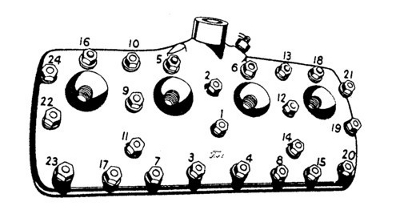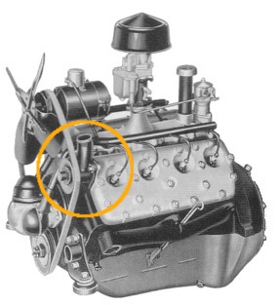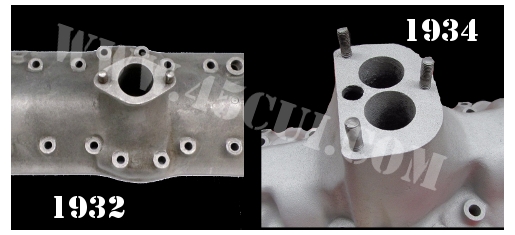16 comments
Comment from: jamesr Member

Comment from: zapp Member

The only way to be 100% sure if you have a 239 cui or a 255 cui is to measure the stroke: Turn the engine till one piston is at the highest position. Mark the position and turn engine until the same piston is at the lowest position. Measure the length between your mark and the piston position. If it is 3 3/4 inch it’s a Ford 239 engine and if it’s 4 inch, it’s a 255 cui Mercury.
But…if you don’t want to open your engine and it all looks “original", you have a high chance to own a Mercury 255 if the color is green and the cylinderheads are 8CM or EAC.
Comment from: Joe Visitor
Hi,
I am trying to identity the engine that I have. This is a description of the nomenclature on the bell housing of our ‘39 coupe: In the middle is a circle; inside the circle is the number “192″ in the upper half, and a “0″ in the lower half.
To the left of the circle is a “1″; to the right of the circle is the letter “S".
Can you tell me what block I have?
Thanks, Joe
PS: Note that the number “1″ in the above designations could also be a letter “I".
Comment from: zapp Member

Some photos might help. Atm I’ve no idea.
If I have to guess, the engine code that is most close to your (192) number is a 1941 Mercury truck engine. Does it fail or pass the pencil test? Examples for 1941 Mercury truck engines:
19D - 3/4 ton truck
19W - 1.5 ton C.O.E.
19Y - 1 ton truck
191W - 1.5 ton C.O.E. (101″ Wheelbase)
Comment from: Richard Visitor
reading part 1 found interesting and informative.
do you have part 2 on later flatheads?
Comment from: zapp Member

Yes, Part 2 and Part 3 (for V12 and European Flatheads).
http://www.45cui.com/45cui/tech/ford-flathead-engine-identification-part-1
http://www.45cui.com/45cui/tech/ford-flathead-engine-identification-part-2
Comment from: Tim Visitor
I have a 1937 Ford pickup. It has a flathead v8 supposedly out of a 53 Merc and I am trying to find out just what motor it is. On the right rear of the block are these numbers, F2723. The last number could be a B and not a 3 but I don’t think so. It is a 24 stud cylinder head.
Comment from: DENNIS Visitor
I HAVE A 51 F2 ..MY MOTOR HAS 24 HEAD BOLTS AND THE HEADS SAY 8 RT BUT THE COLOR LOOKS ORIGINAL AND IS GREEN …IVE HEARED THE COLOR IS WRONG BUT LOOKS ORIGINAL …WERE ANY 51 MOTORS PAINTED GREEN ???
Comment from: zapp Member

Mercury Engines in 1951 were green. Ford engines had a bronze color in that year. the 52/53 Ford were green or red.
Comment from: Ron Visitor
The number stamped on lh rear between head and intake is RC21026 followed by a star. Cannot find anywhere. Help.
Comment from: andreas Member

Hi, we are trying to identify my 21 studs Flathead. The cast number on the bell house says C18. Can you help? Thanks Andreas
Comment from: andreas Member

Hi, we are trying to identify my 21 studs Flathead. The cast number on the bell house says C18.
Can you help?
Thanks Andreas
Comment from: Tom Visitor
I was pretty sure that the BB Ford truck which I just purchased was a 1932 , but I have someone who keeps saying it is a 1933 . The information you gave on the engine was a clincher for me , since my engine has 21 bolt heads and the heads are iron , NOT aluminum ! Thanks so much . Now if I can just find a driver side door………………..
Comment from: rattrackr Member
I have been trying to I’d my 52 5 ton grain motor it is green but heads do not say anything I am use to seeing 8ba or 8 et only has Ford oval and M71 any idea what it is ?
Comment from: Larry Mass Visitor
I have a flatty here the tag says it was built 7 20 48 code c59a then in another spot it has c49a and co1ts and on the heads it is stamped 81t I am confused as to what size bore it should be is it a 239? the piston I removed from it measures 3.235 there is no marking on the piston that says it is oversize is this a standard size piston? I want to rebuild it and put it in a Canadian military pattern vehicle (CMP)
Comment from: tony bickel Visitor
ive got a 1935 ford flathead engine and i want to put 3x2 on it what intake manifold will i have to have make it work



I have a 1952 24 stud/bolt ford flathead 3 stud intake I have been trying to find out more about it. This was helpful to find out how to figure out what type it was. How do you tell a 239 from a 255.